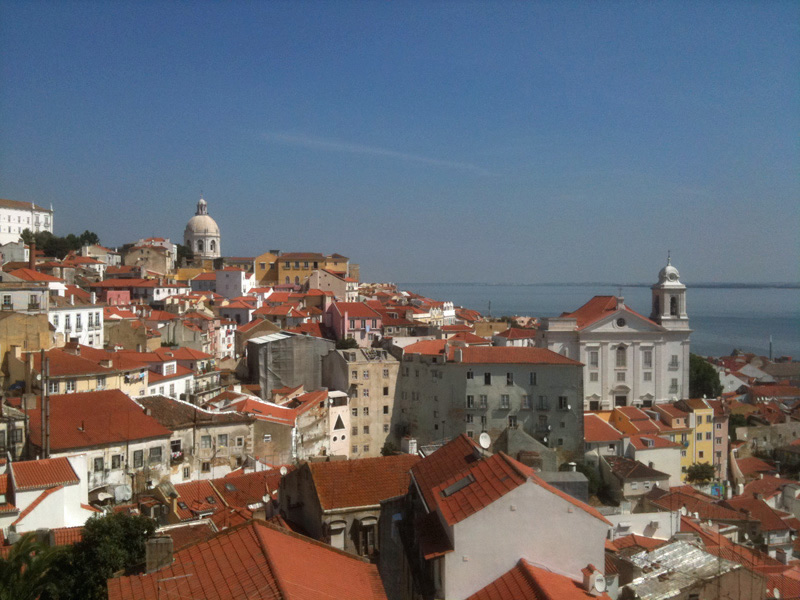

AVENTURA AMOROSA PORTUGUÉSA
|
|
By Les Furnanz |
|
HighOnAdventure.com December 1, 2011 |
|
As he placed the bottle of local Ourem wine before us, our waiter bragged playfully that this was world-best. "It's like the guitar piece you are hearing... soft, warm." He showed us the CD cover and continued, "This music is by our local maestro, Silvino." We nodded as my wife, Rita, avowed her appreciation of wine and music. As we toasted the night, the neighboring couple also raised their glasses to their coastal village of Nazaré and to us visitors. We were soon chatting excitedly. Alfredo was a native of Nazaré and one of Portugal's most renowned Fado singers from the 60's until retiring ten years earlier. His wife, Georgia, and he now lived half the year in Nazaré and the other half in her native Minneapolis, MN. We soon joined tables to share the evening and local seafood meal. By the end of dinner we felt like long-time friends. Alfredo and Georgia’s story of romance had captured our hearts. They first met in Lisbon in 1967. He was a popular club singer, and she was an American stewardess with a weekly Lisbon stopover. “Truly love at first sight,” he said, nodding at her. “It was not long before Alfredo proposed marriage to me,” mused Georgia. “I wanted so much to tie the knot; but he could not consider leaving Portugal; I didn't want to leave the U.S. People in Lisbon were afraid to discuss politics for fear of imprisonment under Salazar. In fact, some of the Fado singers’ lyrics were banned… they were hard times. In 1968 my airline route was changed and we parted sadly.” This was our last night in Nazaré and we didn't want to bid early goodbye to this romantic couple, so we asked if we could treat them to a drink in a local bar. “Yes, yes!” said Alfredo. “Come with us to our favorite spot… no tourists… we will listen to our local guitarist, incredible Silvino. We want you to have good memories and come back to Nazaré!” -- [Click here for a two-minute Heart of Portugal video of Lisbon, Évora, and Nazaré] -- |
 |
|||
|
Lisbons's
Amalfa Quarter and the Téjo River
|
|||
|
LisbonOur visit to the heart of Portugal started with four days enjoying its capitol, Lisbon, one of the world’s oldest cities. Romans and Moors originally settled here, and its glory days were the 15th and 16th centuries when explorers such as Vasco da Gama brought forth sea-trade routes to Africa, Asia and South America. In 1755 an earthquake destroyed 80% of the city’s structures and killed 15% of its residents. Today’s Lisbon is an electrifying mix of rebuilt 18th-century tiled architecture amidst a setting of hills and ancient neighborhoods that survived the disaster. Our favorite quarter was Amalfa, a sailor’s neighborhood that survived the quake and dates back to the 6th century. A neighborhood streetcar ride brought us up through narrow winding streets to Largo Santa Luzia, a hilltop square with entrancing views of ancient houses, churches, and lanes descending to the mouth of the Tejo River. The many restaurants and cafes provided a good selection for a rest stop. From here we took an interesting stroll that included the 8th-century Moorish São Jorge castle and a labyrinth of streets, alleys, and public laundries where we lost ourselves in bustle and chatter. Street musicians provided additional sound and color. We also enjoyed exploring the central Baixa quarter, situated between the hills of Amalfa and Bairro Alta. Baixa was totally rebuilt after the earthquake. It has broad avenues of tiled homes and apartments and the majority of Lisbon’s hotels, stores, and shops. We enjoyed a leisurely stroll southward along pedestrian-only Rua Augusta to riverside square Praça do Comércio. Along the way we enjoyed an entrancing mix of mosaic-decorated buildings, shops, busy shoppers, and the square’s grand arch and statue of King Jose I.
ÉvoraWe bused two hours inland from Lisbon past farms and vineyards to Évora, an ancient Roman settlement in the center of Portugal. Here we settled back for a couple of days and enjoyed the peaceful and historic ambiance. The whitewashed town houses a 1st-century Roman temple and square, a 12th-century cathedral, an eerie 13th-century chapel of bones (built as a Christian reminder of life’s transience), and a 15th-century university. The students provided a spirited élan to the town. A major highlight were the excellent restaurants scattered throughout the tightly-knit neighborhoods.
|
||||||||||||||||||
|
We wandered back streets enjoying scenes of white homes with colorful doors and shutters, laundry lines full of drying clothes, chatting women wearing seven petticoats (centuries-old tradition), smoking townsmen wearing fishhook-filled stocking caps, and soccer-playing children in the squares. The inexpensive restaurants provided fantastic seafood meals. The old market pavilion displayed a grand array of fruit, vegetable, and seafood specialties. We lounged on the wide sandy beach, and then took the funicular up to the cliff-top Sitio section with arresting sea and town views and interesting sites such as the small chapel dedicated to Our Lady of Nazaré. On our last evening we met Alfredo and Georgia, who’s unique story enhanced our own romance with Portugal and its people. We have already booked our return to the Heart of Portugal! Article, Video, Photos by Les Furnanz |